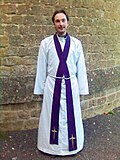Byzantine practice
In The Byzantine Rite practice of the Eastern Orthodox and Greek Catholic churches, the stole worn by a deacon is called an orarion, while that worn by a priest or bishop is called an epitrachelion (a bishop additionally wears an omophorion), all similar in meaning and use to the Western stole. In Greek Orthodox practice, the deacon wears a double orarion, meaning it comes over the left arm and under the right. Minor clerics (and in Greek and Melkite traditions the altar servers as well) wear an orarion wrapped around their waist, crossed in back, and then either crossed again in front and tucked under the belted section or not crossed and tucked in (see explanation of subdeacon below).
The priest's epitrachelion consists of a long strip of cloth, hung around the neck with the two strips fastened together in front, either by buttons or by stitching. The epitrachelion comes down in front almost to the hem of his robes, and is symbolic of the priest's "anointing" (Septuagint: Psalm 132:2; KJV: Psalm 133:2). Traditionally—though not necessarily—the epitrachelion will have seven crosses on it: six in the front (three on each side) and one on the back of the collar. The priest traditionally blesses the cross on the collar and kisses it before he puts it on, and kisses it again when he takes it off. When he is vesting for the Divine Liturgy, he says the following prayer before putting on the epitrachelion:
Blessed is God, Who poureth out His grace upon His priests, like the oil of myrrh upon the head, which runneth down upon the beard, upon the beard of Aaron: which runneth down to the fringe of his raiment. (Cf. Psalm 132:2, LXX)
In the Russian Orthodox tradition, the priest may say a special blessing and sprinkle the epitrachelion with holy water before it is worn for the first time. A priest is not permitted to celebrate even the simplest service, even the Daily Office, unless he is wearing the epitrachelion (and in some traditions the epimanikia, or "cuffs", as well). When a member of the faithful goes to Confession, the priest places the edge of his epitrachelion over the head of the penitent as he confesses his sins. After the absolution, the penitent will often kiss the priest's hand and then one of the crosses on the edge of the epitrachelion. At an Orthodox wedding, the priest will have the bridal couple hold the edge of his epitrachelion as he leads them in a procession three times around the Gospel Book, symbolizing the pilgrimage of life.
The protodeacon or archdeacon wears the orarion "doubled", i.e., over the left shoulder, under the right arm, and passing again over the left shoulder. The two ends hang down, one in the front and one in the back, coming down almost to the hem of his sticharion (dalmatic).
A deacon wears an orarion which simply passes over the left shoulder, the two ends of which hang straight down, one in the front and one in the back, coming down almost to the hem of his sticharion. This is only common in the most traditional Orthodox churches. In many Eastern traditions, the stole is always worn "doubled" unless the deacon in question is wearing only his exorasson (outer cassock) and then it is essentially folded and worn over the left shoulder.
The subdeacon wears his orarion over both shoulders, crossed in the back and the front. Those acting as subdeacons (i.e., vested and serving as subdeacons but without having been ordained) wear their orarion crossed only in the back, to show that they do not bear holy orders.









